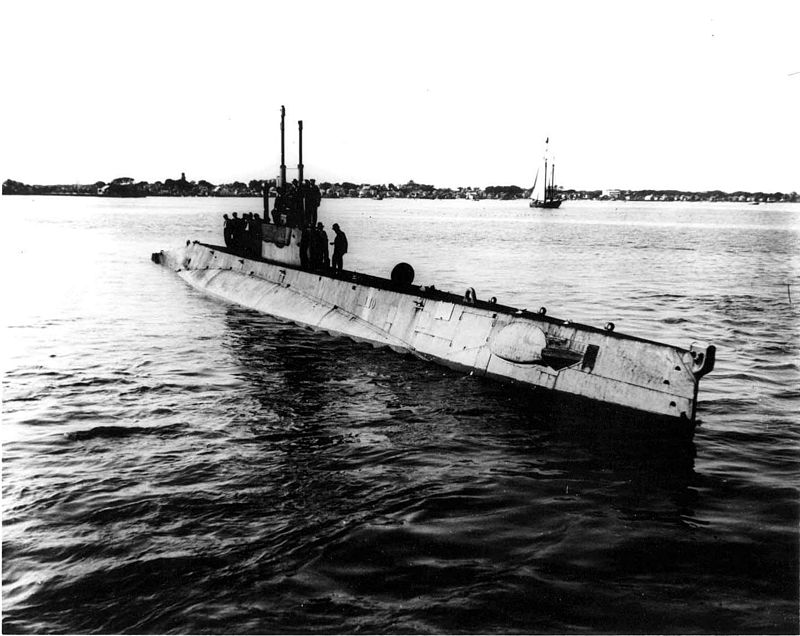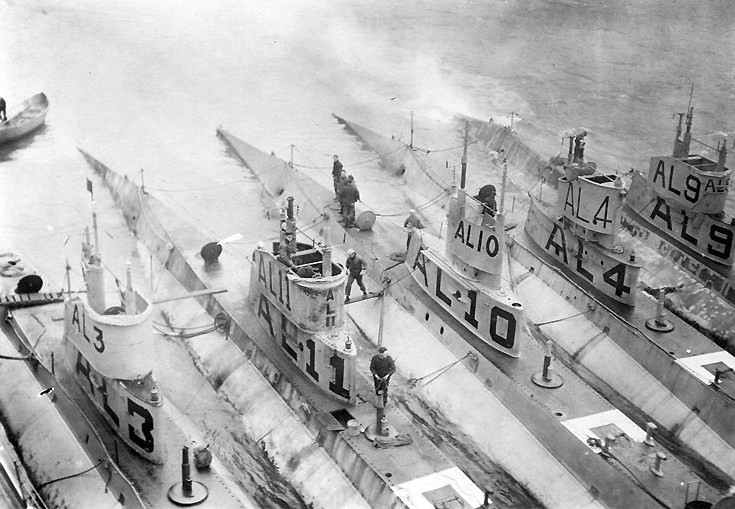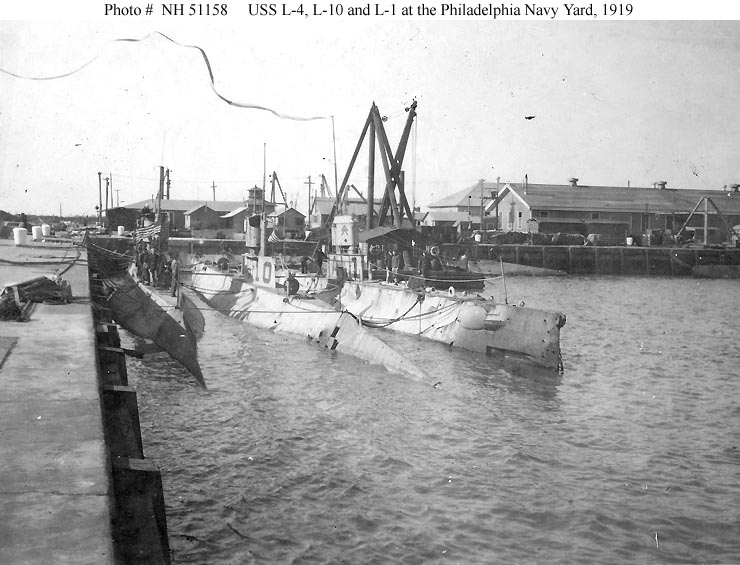Ever wonder what it must have been like to serve on a submarine in World War I? You can’t visit or tour one, since there are no U.S. subs from that war on display. You may have seen and walked through a WW II sub in a museum, or seen one in a movie, but the earlier WW I subs are a mystery to most of us.
Recently, one of my wife’s relatives loaned me the journal of her grandfather, a submariner in WW I. I eagerly read it, and now offer you the following description.

Chief Machinist’s Mate Frank Laugel served aboard the submarine USS L-10 (SS-50). (Back then, they didn’t give submarines names, only alphanumeric designations.) His journal covers the period from Monday, December 3, 1917 to Saturday, February 1, 1919.
The book itself is a U.S. Navy ledger book with lined pages; the cover is brown with purple trim. The binding is covered and protected with gray duct tape. Laugel began writing on page 1 and ended on 106 of 200. His cursive writing is quite legible, and I rarely had to pause to decipher a word. There are oil or grease stains on some pages.
The journal begins by chronicling the sub’s departure from Newport, Rhode Island on December 4, 1917 in the company of other submarines and the submarine tender USS Bushnell (AS-2), the crossing of the Atlantic and arrival at Port Delgado on Sao Miguel Island in the Azores on December 19.
They left Sao Miguel on December 30 to continue the crossing. The crew lost a man overboard, a gunner’s mate, on January 24, 1918. They arrived in Bantry Bay, Ireland on January 26, 1918.
The L-10 and its crew spent the war operating in and around Bantry Bay, going out for short excursions and returning to tie up alongside USS Bushnell. They saw little war action. They rarely sighted an enemy and never sunk anything.
The submarine left Ireland on Friday, January 3, 1919 and arrived at the Philadelphia Navy Yard on Saturday, February 1, the date of the final journal entry.
When the sub is at sea, Laugel’s entries carefully record the weather, the time of day the ship dives and surfaces, the depths they reach, and the number of engines running at any time. He identifies the other ships they sighted.
Laugel’s in-port journal entries state when other ships, both U.S. and allied, arrive and leave. He details the equipment that breaks aboard the sub and it seems he spends most of his days in port fixing things or cleaning the boat.

Journals are personal logs, begun for various personal reasons. A journal writer never intends for others to read his words, and therefore excludes things with which he’s intimately aware and feels no need to describe.
That’s true with Laugel’s journal. His entries are extremely impersonal. Except for a few brief mentions of the captain, he never mentions the names of any fellow crewmen, including the one lost overboard. Absent is any description of the submarine itself, or what life aboard was like.
Perhaps some of that is due to security restrictions, but then why did he feel free to note the submarine’s depth and the sightings of other vessels? Moreover, there would be nothing classified about his liberty time ashore, yet these entries contain equally sparse descriptions of this time, with brief mentions that he “went out to dinner…went to a dance…went to a movie…”
The closest Laugel gets to anything personal is in noting the receipt of every letter from Frieda, his girlfriend. He also mentions the occasional chances he gets to talk to Walter, presumably a relative or friend assigned to a different ship.
If Laugel feared death due to enemy action or submarine malfunction, he didn’t feel a need to write about it. There is one brief mention about the risks of war, and his attitude about that is philosophical.

A journal-writer is often so close to events that he cannot know what will be important to others. Laugel describes the initial crossing of the Atlantic as mostly routine, free of drama. Yet, according to the Wikipedia entry on USS L-10, the submarine’s captain, Lieutenant Commander James C. Van de Carr, received the Navy Cross for his distinguished service.
In part, that citation reads, “While en route from Newport to the Azores, the submarine which he commanded was separated from the escort and the other submarines of the squadron, leaving him without a rendezvous. He thereupon proceeded to destination successfully, assuming the great responsibility of starting a 1,700-mile Atlantic Ocean run in winter weather and in a submarine of a class that had never been considered reliable under such conditions.”
From the journal, I can infer some things about Laugel, but these are just suppositions. Assuming he took the same care with the sub’s engines that he did in penning his journal, he was in large part responsible for the sub’s successful ocean crossing. A strong sense of humility must have prevented him from taking credit for any significant repairs; he only mentions team efforts, that “we” did this or that. I also sense he was a practical and methodical man, reserving his strong emotions for Frieda alone.
I’m grateful for the chance to read Frank Laugel’s journal, and I shouldn’t criticize him for writing in such a dry style. He was a machinist’s mate scribbling in a journal for his own reasons. He wasn’t writing a novel or a movie script.
Frank Laugel, along with all U.S. submariners, has earned the unending admiration of—
Poseidon’s Scribe

Hi Steve, I just read your posting about my Grandfather’s journal and I really enjoyed it, and you truly got a sense of what kind of man he was. From what I understand from my father, he was strict and demanding but with his Granddaughters he was a marshmallow…..he spoiled us rotten, told us wonderful tales and we loved him so very much. We would spend our summers with him when they lived on his boat in Fl.
Thanks, Kathy, for loaning me your grandfather’s journal and for allowing me to put out a blog post about it. I’m gratified that you think I managed to glean a sense of what sort of man he was. I wish I’d met him; he sounds like a wonderful man.